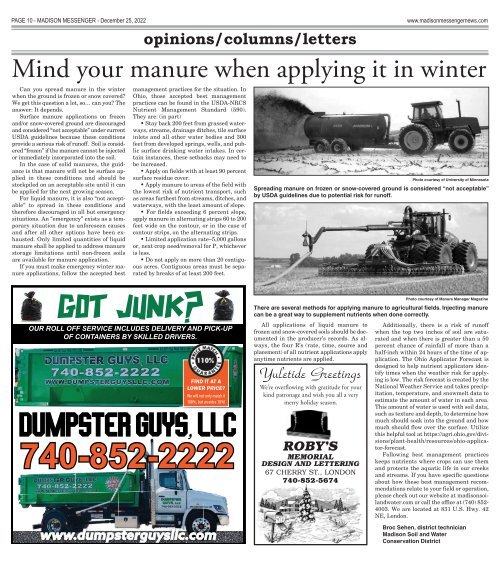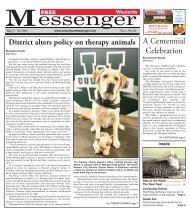Madison Messenger - December 25th, 2022
You also want an ePaper? Increase the reach of your titles
YUMPU automatically turns print PDFs into web optimized ePapers that Google loves.
PAGE 10 - MADISON MESSENGER - <strong>December</strong> 25, <strong>2022</strong><br />
opinions/columns/letters<br />
www.madisonmessengernews.com<br />
Mind your manure when applying it in winter<br />
Can you spread manure in the winter<br />
when the ground is frozen or snow covered?<br />
We get this question a lot, so… can you? The<br />
answer: It depends.<br />
Surface manure applications on frozen<br />
and/or snow-covered ground are discouraged<br />
and considered “not acceptable” under current<br />
USDA guidelines because these conditions<br />
provide a serious risk of runoff. Soil is considered<br />
“frozen” if the manure cannot be injected<br />
or immediately incorporated into the soil.<br />
In the case of solid manures, the guidance<br />
is that manure will not be surface applied<br />
in these conditions and should be<br />
stockpiled on an acceptable site until it can<br />
be applied for the next growing season.<br />
For liquid manure, it is also “not acceptable”<br />
to spread in these conditions and<br />
therefore discouraged in all but emergency<br />
situations. An “emergency” exists as a temporary<br />
situation due to unforeseen causes<br />
and after all other options have been exhausted.<br />
Only limited quantities of liquid<br />
manure shall be applied to address manure<br />
storage limitations until non-frozen soils<br />
are available for manure application.<br />
If you must make emergency winter manure<br />
applications, follow the accepted best<br />
management practices for the situation. In<br />
Ohio, those accepted best management<br />
practices can be found in the USDA-NRCS<br />
Nutrient Management Standard (590).<br />
They are: (in part)<br />
• Stay back 200 feet from grassed waterways,<br />
streams, drainage ditches, tile surface<br />
inlets and all other water bodies and 300<br />
feet from developed springs, wells, and public<br />
surface drinking water intakes. In certain<br />
instances, these setbacks may need to<br />
be increased.<br />
• Apply on fields with at least 90 percent<br />
surface residue cover.<br />
• Apply manure to areas of the field with<br />
the lowest risk of nutrient transport, such<br />
as areas furthest from streams, ditches, and<br />
waterways, with the least amount of slope.<br />
• For fields exceeding 6 percent slope,<br />
apply manure in alternating strips 60 to 200<br />
feet wide on the contour, or in the case of<br />
contour strips, on the alternating strips.<br />
• Limited application rate—5,000 gallons<br />
or, next crop need/removal for P, whichever<br />
is less.<br />
• Do not apply on more than 20 contiguous<br />
acres. Contiguous areas must be separated<br />
by breaks of at least 200 feet.<br />
Photo courtesy of University of Minnesota<br />
Spreading manure on frozen or snow-covered ground is considered “not acceptable”<br />
by USDA guidelines due to potential risk for runoff.<br />
All applications of liquid manure to<br />
frozen and snow-covered soils should be documented<br />
in the producer’s records. As always,<br />
the four R’s (rate, time, source and<br />
placement) of all nutrient applications apply<br />
anytime nutrients are applied.<br />
Yuletide Greetings<br />
We’re overflowing with gratitude for your<br />
kind patronage and wish you all a very<br />
merry holiday season.<br />
ROBY’S<br />
MEMORIAL<br />
DESIGN AND LETTERING<br />
67 CHERRY ST., LONDON<br />
740-852-5674<br />
Photo courtesy of Manure Manager Magazine<br />
There are several methods for applying manure to agricultural fields. Injecting manure<br />
can be a great way to supplement nutrients when done correctly.<br />
Additionally, there is a risk of runoff<br />
when the top two inches of soil are saturated<br />
and when there is greater than a 50<br />
percent chance of rainfall of more than a<br />
half-inch within 24 hours of the time of application.<br />
The Ohio Applicator Forecast is<br />
designed to help nutrient applicators identify<br />
times when the weather risk for applying<br />
is low. The risk forecast is created by the<br />
National Weather Service and takes precipitation,<br />
temperature, and snowmelt data to<br />
estimate the amount of water in each area.<br />
This amount of water is used with soil data,<br />
such as texture and depth, to determine how<br />
much should soak into the ground and how<br />
much should flow over the surface. Utilize<br />
this helpful tool at https://agri.ohio.gov/divisions/plant-health/resources/ohio-applicator-forecast.<br />
Following best management practices<br />
keeps nutrients where crops can use them<br />
and protects the aquatic life in our creeks<br />
and streams. If you have specific questions<br />
about how these best management recommendations<br />
relate to your field or operation,<br />
please check out our website at madisonsoilandwater.com<br />
or call the office at (740) 852-<br />
4003. We are located at 831 U.S. Hwy. 42<br />
NE, London.<br />
Broc Sehen, district technician<br />
<strong>Madison</strong> Soil and Water<br />
Conservation District


















